Historical Color Matters

The colors of buildings and monuments provide unique insights into the culture and the materials available at that time in history. For example: the striking reds of the Heian Shinto shrine in Japan, the golden stones of the pyramids of Egypt, and the green and blue tiled domes of the Bibi-Khanym Mosque in Uzbekistan (pictured above).
But what about the colors of dwelling places? Ordinary homes? What can we learn about the people, their traditions, the economy, the weather, and the geography of a place? If we concentrate on painted structures, what can the colors of paint tell us?
Finally, if we narrow the focus to the homes of the working class who lived in one geographic location, what will 100 years of paint colors reveal?
"The Historical Colors of Hawaii Plantation Housing" project did precisely that. The process was a visual, physical, and scientific analysis the colors of paint of existing homes on the island of Kaua'i. The end result was a key to the history of the people and the industry that built the Hawaiian Islands and a specification of the colors per current color systems.
A Brief History or Hawaiian Architecture

In ancient times, the Hawaiian people lived in simple structures constructed of natural materials such as lava, coral, logs and thatching from pili grass and coconut fronds. The term "grass shack" refers to many of these simple homes.
After the arrival of the Europeans in the late 18th century, this architectural tradition underwent a revolutionary change when the new population of missionaries from the United States erected frame houses (in a style derived from buildings in New England). During the late 19th and 20th century residential homes were built. The style became known as "Hawaiian plantation architecture."
The "plantation style" originated in the homestead areas that housed plantation laborers. This work force came from China, Japan, the Philippines, Portugal and many other countries to work on sugarcane plantations, and to a lesser extent pineapple plantations, rice farms and other agricultural endeavors.
Popular trends from California and elsewhere on the continental U.S. emerged in the 1970s and 80s, and eventually dominated the housing industry. As the 21st century unfolds, the plantation style is appreciated for its Hawaiian authenticity and has become a model for new construction.
The following is a summary of how the research about the historical colors of plantation housing in Hawaii was conducted. It is intended to provide an overview of methods used in historical color research and to inspire others.
The Historical Colors of Hawaii Plantation Housing
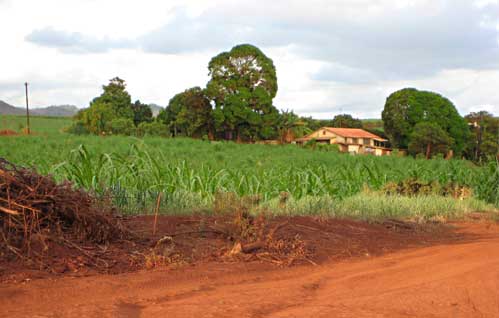
Introduction
Historical architectural research of this scope required a thorough survey of all existing plantation homes in the plantation camps and other areas, interviews with residents, meetings with other historical experts, analyses of historical documents, and microscopic examination of paint samples.
The project covered all the existing homes in the six remaining plantation housing "camps" and six other areas on the island of Kaua'i in the state of Hawaii, U.S.. Prior to this study, no one had surveyed all the plantation camps on Kaua'i, and no one had examined the paint colors under a microscope. The project took almost a year to complete.
This survey covered the following large plantation housing areas: Kaumakani, Camp 6, Pakalas, Numila, Waimea, and Kekaha. It also included the following areas where only a few homes remain: Hanamaulu, Kapaa, Kealia, German Hill, and Koloa Some of the earliest unrestored homes had been moved and stored by Mike Faye at Kikiaole Construction lot.
The process included several phases: The Survey, Research, Microscopic Analysis, and Conclusions
Part 1 - The Survey and Paint Sampling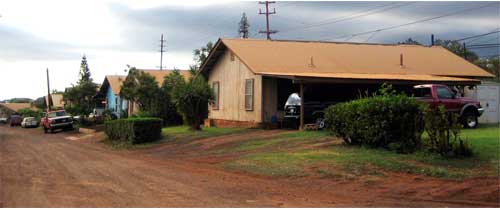
The research team walked the streets of every plantation camp, took photographs, extracted paint samples, and compiled a list of the existing colors.
In some cases, such as the largest existing plantation housing area of Kaumakani camp, the existing paint colors were the weathered remains of the colors originally used in 1946. In other areas, the original colors were covered by new paint.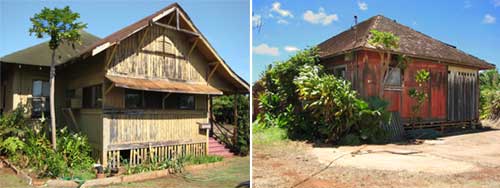
Remnants of plantation homes from the late 19th and early 20th century were found hidden in brushy areas such as those Hanamalu and in areas owned by the Faye family.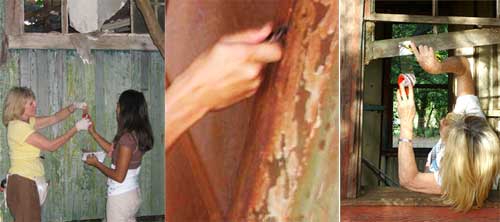
Approximately 200 paint samples were gathered from protected areas such as under the eaves. Interviews with current and former residents provided valuable information. Retired workers- and especially those who had lived in the housing 50 years (or more) ago - told their stories about the plantation homes. A sampling:
Interviews with current and former residents provided valuable information. Retired workers- and especially those who had lived in the housing 50 years (or more) ago - told their stories about the plantation homes. A sampling:
Mr. Ashida of Numila Camp said that the original homes were either white washed or painted with creosote (a tar which was used as preservative). He remembered that the boat that transported the wood for the first plantation homes did not dock. They tossed the wood overboard and let it "float" to shore. Apparently this salt-water soak is responsible for the wood's resistance to termites today. He also said that prior to WWII, the plantation manager selected his favorite color for new construction. In later years, people who maintained their homes were given free paint and the rent was lowered to $50 in return for repainting.
Mr. Raymond Espino of Kaumakani Camp (1946) said that the red dirt from the sugar cane fields make upkeep difficult.
Others interviewed recalled that homes were white or dark green. Some remembered that the homes in their camp were all dark grey. In almost every case, the plantation owner chose the colors.
Interviews with historical organizations and other experts provided additional information. A sampling:
Chris Faye, the great granddaughter of the Waimea Plantation owner, said that residents made their own paint using a linseed base prior to the 1920s.
Bob Scheck, curator of the Grove Farm Museum said that a "shingle stain green" mixed with creosote (tar) was used on the exteriors during the late 19th century.

A one-of-a-kind course for Interior Designers, Architects, and Industry Pros
Online learning from the author of Color Matters
Part 2 - Research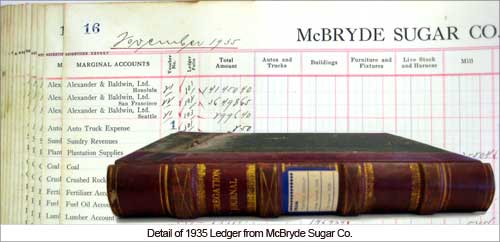
A valuable collection of "Hawaii Sugar Planters' Association – Plantation Archives" in the University of Hawaii's Hamilton Library were reviewed. (For the most part these papers and bound folders can be examined in a special research area.)
Research was also conducted at the Kaua'i Museum and the Kaua'i Lihue Public Library
The 1948 Lewers and Cooke paint catalogue also provided clues. Unfortunately, the chemistry of paints that were ordered is not available.
Part 3 - Microscopic Analysis
Over 200 paint samples of paint and other finishes from the plantation homes on Kauai were examined under a microscope. A Nikon SMZ-800 Microscope with a Morell MI-10 Fiber Optic Illuminator and an Olympus SZ40 Stereozoon microscope were used.
Edge-view sectioned paint samples were the basis of the examination. These included the inner surface of wood (the indicator of the start of the historical paint applications) and subsequent layers of paint or stains.
These historic paint samples were color-matched under uniform lighting conditions.
Observations:
In some cases there were 4 layers of colors beginning with a stain, followed by 3 layers of paint.
The hundred-year-old paints scraped from rotting wood remains were evidence of traditional pigments. (Anyone who has ever squeezed paint out of a tube of oil paint would recognize pthalocyanine blue.)
Note: Chemical analysis was not conducted because it is extremely costly for just one chip of paint – and in this case there were 200 samples.
Part 4 - Conclusions
The stories revealed by the colors used on the plantation homes proved to be more valuable than the identification of the colors per se.
The colors told the story of the people and the industry that built the islands of island of Hawaii. It was a story of immigrants — from Japan, China, the Philippines, and Portugal — whose descendants now populate the islands.
The research revealed the difficult living conditions of men and women (who some say were "slave laborers"). A retired worker recalled how the lives of first generation of workers were like plantation slaves and quoted the lyrics of "16 Tons":
"You load sixteen tons what do you get
Another day older and deeper in debt"
In later years, the colors showed how living conditions were improved when the Unions arrived. Homes were constructed; homes were painted.
Before and after WWII, the colors of the paint colors bore witness to the remoteness of this Hawaiian island. More often than not, whatever paint was on hand in the paint factories on the continental U.S. was shipped to the islands. The excess of dark grey paint was the result of "battleship gray' surplus paint after WWII. The bright aquas and yellows were most likely interior paint colors — the only paint available at that time.
In conclusion, these were not colors that were chosen for aesthetic value — i.e. to create an attractive exterior. Furthermore, they were not selected for criteria used today such as: relationships with the landscape, environmental impact (hide dirt, soot, etc.).
Instead, they reflected that point in time, the availability of materials, the lives of the workers and industry that built the state of Hawaii.
Project Details:
Color Consultant: Colorcom, Jill Morton
Ms. Morton is a former faculty member of the School of Architecture, University of Hawaii and the author of the Color Matters website. Her ebook - Color Logic includes the color theories she taught in an introductory course for architects.
Research Team: Zachary Toyofuku, Elizabeth Llego, Michelle Jose
Links
Kauai Sugar Plantations
Hawaii Architecture
The Historical Colors of Ewa Plantation Hawaii
(another project by the team from Colorcom)




